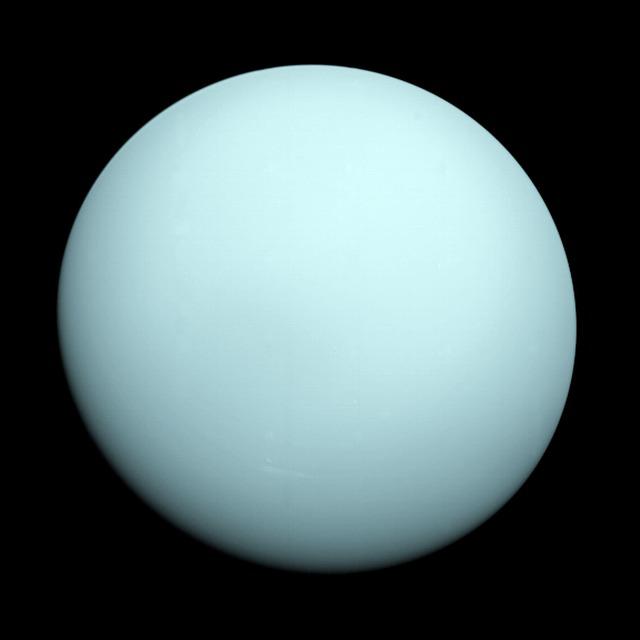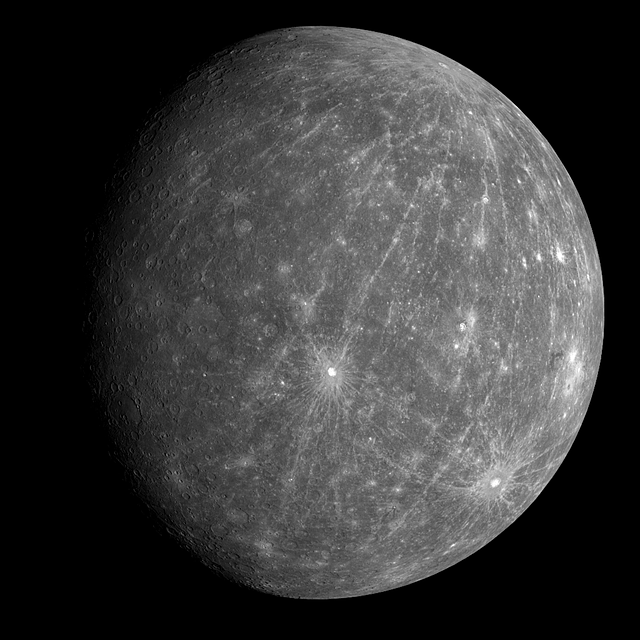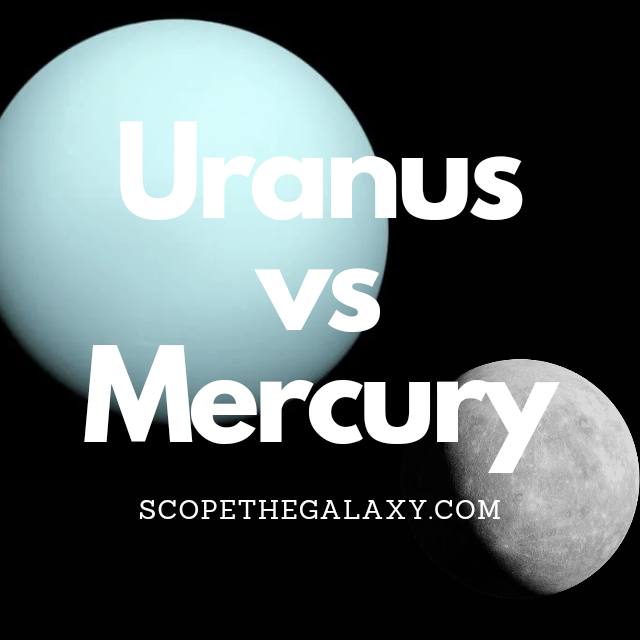*This post may contain affiliate links. This means we may make a commission if you purchase an item using one of our links*
The main differences between Uranus and Mercury is that the former is gas based ice giant that is the 7th farthest planet from the Sun, has 27 moons, has an axial tilt of 98 degrees which means that it is practically on its side whereas Mercury is a rocky terrestrial planet, that is closest to the Sun, has no moons and, has a practically straight axial tilt of 2 degrees.
For a more in depth look at both these planets along with the differences and similarities, continue reading.
What Is The Planet Uranus?
Table of Contents

Uranus is the 7th farthest planet from the Sun and the 3rd largest planet in our solar system, coming in at a diameter of 50,724 km. This means that roughly 63 Earth’s could fit inside this ice giant.
In regards to why this cyan blue planet is referred to as an ice giant, it’s down to it’s composition. Uranus is made mostly of methane, ammonia and water with its atmosphere mostly consisting of hydrogen and helium, much like the Sun, and the other giant planets in our solar system.
Due to its distance from the Sun, it takes Uranus 84 years to complete one orbit our central star, whereas it’s axial rotation is much faster than even our Earth at 17 hours per rotation.
As a result of its distance from the Sun, ice based composition and faster rotation levels, Uranus is far from an ideal place to live in let alone have the potential to support life.
Its base temperature is generally a chilling -190 to -200 degrees Celsius and its rocky core, although hot, is still on the cooler side for a large planet sitting around the 5,000 degrees Celsius range.
The planet’s winds are also very fast often hitting 900 km/h, which is roughly twice that of Earth’s most powerful turbulent wind speeds.
In regards to the moons surrounding this cyan planet, we’ve discovered 27 small ones orbiting it. Furthermore, it has 13 rings surrounding it which also means Uranus has the most abundant collection of rings surrounding in our solar system, which is even more than Saturn.
One of the Uranus’ most unique features would include the manner in which it rotates around its axis. As opposed to the slightly angled rotation that the likes of Earth, Saturn and most other planets display, Uranus’ axis is positioned at a 98 degree angle.
What this means is this ice giant completes an axial rotation on its side as opposed to the relatively up straight positioning of most of the other planets in our solar system.
What Is The Planet Mercury?

Mercury is the planet closest to our Sun and would fall under the terrestrial planet moniker. Out of the 8 main line planets Mercury is also the smallest, coming in at 4,879km.
This planet is known for having its fair share of craters, which is mostly down to its thinner non protective atmosphere that is unable to stop interstellar debris from striking its surface.
Despite its close proximity to the Sun, Mercury is not the hottest planet in our solar system but, it does come in second, just behind Venus. It’s surface temperature is around 430 degrees on the upper end with the average temperature around 167 degrees Celsius whereas its core is far hotter at around 1,600 – 3,000 degrees Celsius.
Due to it close proximity to our local star, Mercury is unable to sustain a moon around its orbit and even has a very unique rotation around the Sun where it has 3:2 orbital resonance with the Sun.
As for how long it takes for the planet to rotate around our yellow dwarf star, its the shortest time period of 88 days for obvious reasons, whilst a single day on the planet takes 58.65 Earth days to complete. Its axial tilt is only 2 degrees to the right, making it amongst the straightest planets in the solar system too.
How Are Uranus And Mercury Similar?
Uranus and Mercury do not have too much in common but, there are still some common features, some of which include the following:
- Both have a hotter central core.
- Both are a spherical in shape.
- Both orbit the Sun in a circular pattern.
- Neither are tidally locked to the Sun.
Differences Between Uranus And Mercury
In regards to the differences between these two, they include the following:
- Uranus has 13 rings around it whilst Mercury has 0.
- Uranus has 27 moons whilst Mercury has 0.
- Mercury rotates in a practically straight manner with an axial tilt of 2 degrees whereas Uranus’ axial is 98 degrees meaning it rotates on its side.
- Mercury is a terrestrial planet whereas Uranus is a gas based ice giant.
- Mercury has a lot of craters on its surface but, Uranus cannot have craters as it does not have a solid surface.
- Uranus is the 7th farthest planet from the Sun whilst Mercury is the closest. As a result it takes Uranus 84 years to complete an orbit around the Sun whilst Mercury does so in 88 days.
- Uranus rotates practically on its side with an axial tilt of 98 degrees whilst Mercury is almost straight with a 2 degree axial tilt.
- A day on Mercury lasts for around 58.65 days whilst a day on Uranus is 17 hours.
- Mercury is far hotter than Uranus with an average temperature of 167 degrees Celsius whereas Uranus has a temperature of around -190 to -200 degrees Celsius.
- In regards to their core temperatures, Mercury’s is between 1,600 – 3,000 degrees Celsius whereas Uranus’ core is 5,000 degrees Celsius.
- Mercury is much smaller than Uranus with a diameter of 4,879km as opposed to Uranus’ diameter of 50,724km.
- Mercury is denser but lighter with a mass 3.285 × 10^23 kg whereas Uranus’ mass is 8.681 × 10^25 kg.
Summary
Mercury and Uranus are part of the same solar system and do orbit the same star however, they differ in more ways than they are similar, whether it be the differences in temperature, size, the strength of the magnetic and gravitational fields along with their general composition.
That’s why even if both planets reside close to each other, they aren’t all that similar.


